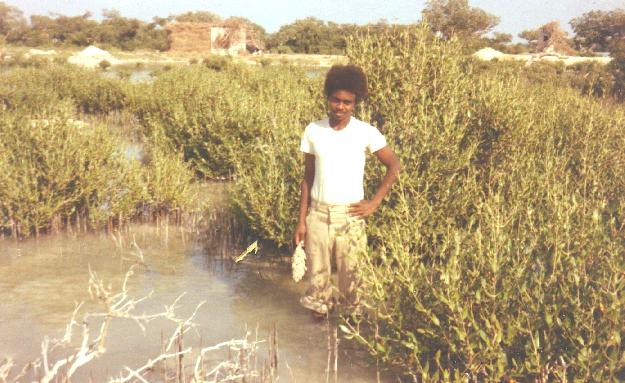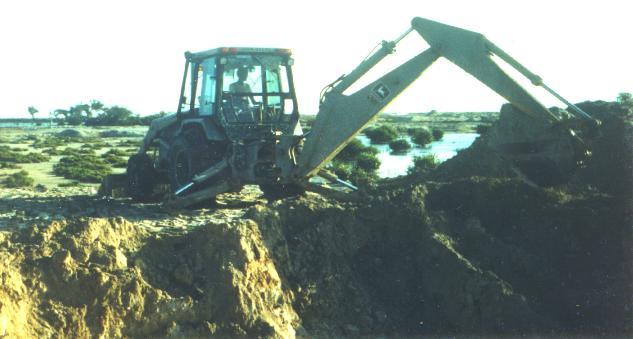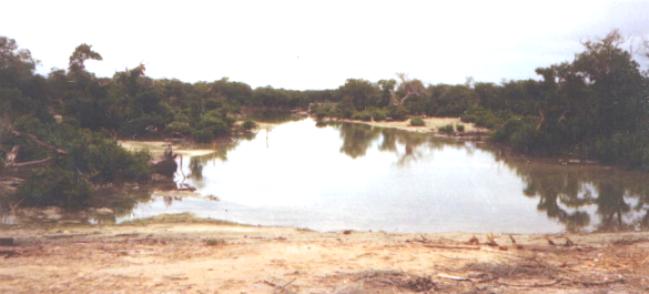Main Menu-The Manzanar Project Test Project on the Red Sea in Eritrea
A demonstration project in Eritrea has been highly successful. The process is very simple. Artificial mangrove swamps are created by digging large areas to the depth of one foot below the average high tide level. Mangroves, which grow into five foot tall bushy shrubs in about six months, are planted using the fruit and propagules. The mangrove trees provide nourishment and shelter for large numbers of fish, shrimp and crab which feed indirectly from the decomposing leaves.
Next to the mangrove swamps, deeper ponds are dug which are fertilized with a mixture of camel and goat dung. The algae that grow in this environment support a fish that is related to the algae-mud eating carp, mullet. These fish grow from the fingerling stage to one pound in four months when they are caught, cleaned, and shipped to the highlands. The viscera and heads are used to feed crab, shrimp and carnivorous fish that are cultured in other ponds or in cages anchored off shore.
The project was first implemented in 1988 just outside a small town, which we refer to as MANZANAR, a local government seat with a population of 500. The town is relatively stable with carpentry, mechanical, and ship repair as a vocational basis. The location is far from the civil disturbances that are featured in the international news media. MANZANAR is located along the coast about 250 miles southeast of Port Sudan, a deep-water port city of 230,000 inhabitants. Access to MANZANAR is from the sea or international airport at Port Sudan, then by an improved but unpaved highway that requires about ten hours of travel.
Up to this point in time, three types of enclosures have been utilized for the MANZANAR project: man-made shoreline ponds, natural fish ponds, and protected waters inside barrier reefs. Man-made shoreline ponds are dug with a backhoe on the beaches. Ponds 3 to 4 feet deep have been constructed for this project, each connected to the sea by a channel in order to use tidal action for water exchange. Gates made either of rocks piled up or of wood are used to allow passage of water at high tide while not allowing the fish to escape. The exchange of 10% to 35% of the total water volume occurs with each tide change under all tidal conditions. This is enough to maintain water quality. Natural fish ponds are configured in low-lying shallow bays. Across a channel a net is stretched and fastened along the bottom with mud, sand, and rocks. At high tide the net is raised and held up with branches or other support thereby enclosing the fingerlings within the resulting bay where they are fed until maturity. Natural ponds are the most cost effective systems. In Eritrea, a natural pond of about 25 acres was enclosed in three hours using only 150 square yards of net and 30 branches. Thousands of acres of calm, protected waters result from the barrier reef that parallels the Eritrean coast. This area of slow, undulating current is ideal for a third method of fish farming: in cages floating on the surface and anchored in place. Cages 15 by 9 by 3 feet framed of wood and covered with netting provide an ideal natural environment for fish. Fish Farming and Ranching in the Eritrean Test Project © 1998-2006, Wallace L. McKeehan, All Rights Reserved |


 Eritrea
was chosen as the site for the project demonstration for several reasons, most
importantly, the indigenous population regularly faces famine due to the impossibility of
developing an agrarian economy in a desert area. Equally important to the success of this
or any project was the commitment, intelligence, and energy levels of the affected
population. The Eritreans have proven themselves to be industrious and interested.
Eritrea
was chosen as the site for the project demonstration for several reasons, most
importantly, the indigenous population regularly faces famine due to the impossibility of
developing an agrarian economy in a desert area. Equally important to the success of this
or any project was the commitment, intelligence, and energy levels of the affected
population. The Eritreans have proven themselves to be industrious and interested. Eritrea
has over 620 miles of coast, most of it in gradually sloping beaches and shallow bays with
thickets of mangroves along the waters edge. The perfect environment for fish farming.
here in the shallow water fish, crab, and shrimp live and breed supported by plankton,
algae, and organisms that grow among the mangrove roots. Mullet, milkfish, sea bream, red
snapper and the fingerlings of all thrive. Somewhat more than 500 yards offshore,
thousands of acres of coral reef offer shelter to grouper, emperor, and many other
species. Water quality in this area is without pollutants; temperatures that range between
77 and 80 degrees Fahrenheit throughout the eight month fish maturation period are ideal
for maximizing production. Temperatures up to 131 degrees Fahrenheit during the June
through September period provide the opportunity for draining and drying the ponds in
preparation for the next production cycle.
Eritrea
has over 620 miles of coast, most of it in gradually sloping beaches and shallow bays with
thickets of mangroves along the waters edge. The perfect environment for fish farming.
here in the shallow water fish, crab, and shrimp live and breed supported by plankton,
algae, and organisms that grow among the mangrove roots. Mullet, milkfish, sea bream, red
snapper and the fingerlings of all thrive. Somewhat more than 500 yards offshore,
thousands of acres of coral reef offer shelter to grouper, emperor, and many other
species. Water quality in this area is without pollutants; temperatures that range between
77 and 80 degrees Fahrenheit throughout the eight month fish maturation period are ideal
for maximizing production. Temperatures up to 131 degrees Fahrenheit during the June
through September period provide the opportunity for draining and drying the ponds in
preparation for the next production cycle.